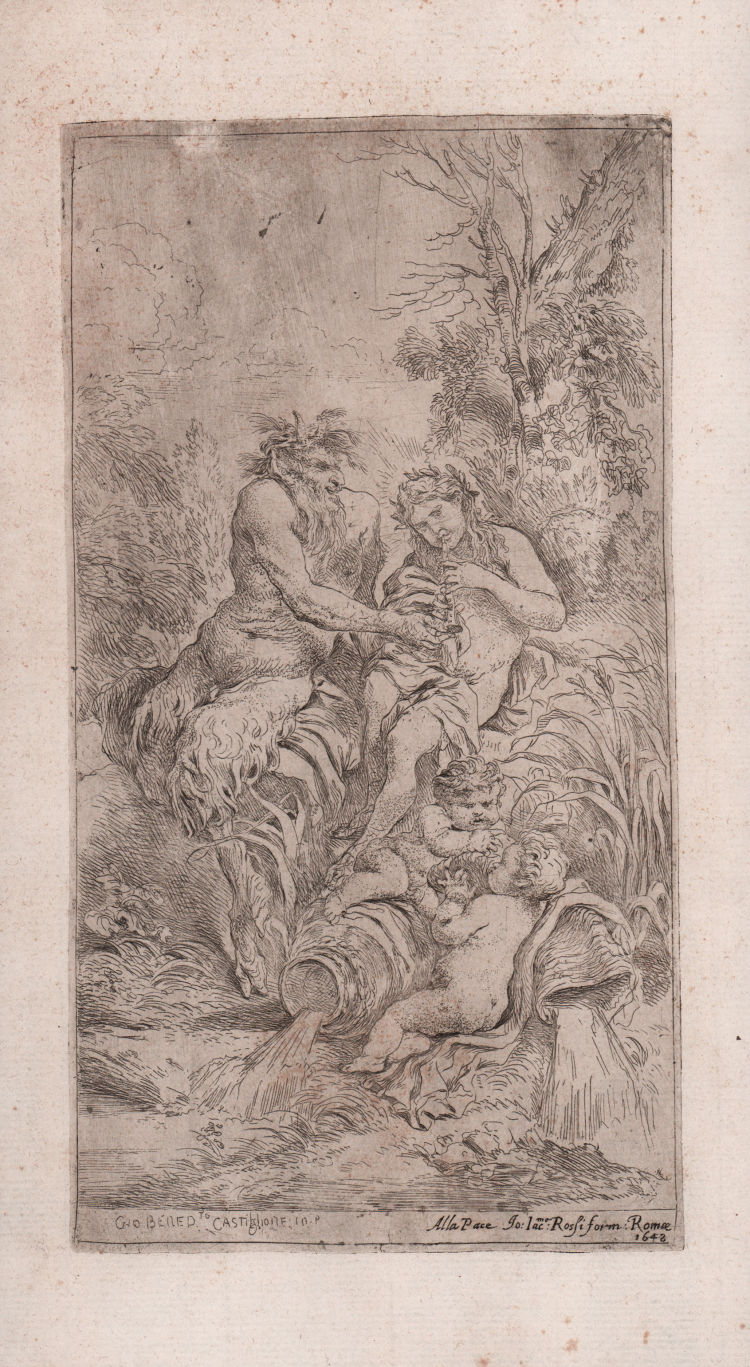



| Reference: | S42518 |
| Author | Giovanni Benedetto CASTIGLIONE detto "Il Grechetto" |
| Year: | 1645 ca. |
| Measures: | 117 x 215 mm |


| Reference: | S42518 |
| Author | Giovanni Benedetto CASTIGLIONE detto "Il Grechetto" |
| Year: | 1645 ca. |
| Measures: | 117 x 215 mm |
Etching, circa 1645/47, signed in plate at lower left.
Exemplar in the third state of three, with the imprint of Giovanni Giacomo de Rossi alla Pace and the date 1648.
Excellent proof, printed with plate tone on contemporary laid paper with watermark "lily in the circle with crown", with wide margins, small oxidation at the bottom center, otherwise in excellent condition.
The subject of this engraving, defined by Bartsch as Pan e Olimpo, has been identified by P. Rosenberg (Un nouveau Poussin au Louvre: Olimpos et Marsyas, in "La Revue du Louvre", 19, n. 2, 1969, p. 92), who copied it from an early painting by Poussin now in the Louvre, coming from Mantua, where the young Castiglione might have seen it.
The mythical episode illustrated refers to Marsyas, who taught the young Olympus to play various musical melodies. In addition to Poussin's prototype, Castiglione seems to take into account in this scene also the ancient statuary group with Pan teaching a young man to play the bagpipes, already in the Ludovisi collection and engraved by François Perrier.
Our engraving can be dated on stylistic grounds to the Genoese period of the artist's activity, between 1645 and 1647, the years in which he suffered and translated more into his creations the influence of the works of Nicolas Poussin and of his particular neo-Venetian heroic classicism.
BIBLIOGRAFIA
Gori Gandellini, 1810, VIII, n. XLVIII; Bartsch, 1821, XXI, n. 15; Le Blanc, 1854, I, n. 20; Percy, 1971, n. E 11; Bellini, 1982, n. 17; Massari, Tra mito e allegoria, immagini a stampa nel ‘500 e ‘600, pp. 408-409, n. 153, III/III.
Giovanni Benedetto CASTIGLIONE detto "Il Grechetto" (Genova 1616 - Mantova 1670)
|
His origin and his edication in Genua led Castiglione to make acquaitance with the Flemish painting, especially through Jaan Roos e Van Dyck from whom he took the warm, vibrating chromatism.
He lived in Rome from 1632 to 1635 and from 1647 to 1651; among the two periods in Rome, he lived in Naples and he also started studying the intellectualistic classicism of Poussin.
His favourite subjects, both in painting and engraving, were taken from the classical moralism of Stoicism, very typical in Poussin, which enabled him to create his own peculiar repertoire, much more refined in comparison with contemporary artists.
He spent his last working years in Mantua, at the Duke’s Palace; the production of this period enhances his chromatism and the visionary elements of his previous production.
Castiglione has been a silful engraver; he loved this particular art for he thought it was the main mean to widespread his iconography. He was the first, in Italy, to appreciate and imitate Rembrandt.
|
Giovanni Benedetto CASTIGLIONE detto "Il Grechetto" (Genova 1616 - Mantova 1670)
|
His origin and his edication in Genua led Castiglione to make acquaitance with the Flemish painting, especially through Jaan Roos e Van Dyck from whom he took the warm, vibrating chromatism.
He lived in Rome from 1632 to 1635 and from 1647 to 1651; among the two periods in Rome, he lived in Naples and he also started studying the intellectualistic classicism of Poussin.
His favourite subjects, both in painting and engraving, were taken from the classical moralism of Stoicism, very typical in Poussin, which enabled him to create his own peculiar repertoire, much more refined in comparison with contemporary artists.
He spent his last working years in Mantua, at the Duke’s Palace; the production of this period enhances his chromatism and the visionary elements of his previous production.
Castiglione has been a silful engraver; he loved this particular art for he thought it was the main mean to widespread his iconography. He was the first, in Italy, to appreciate and imitate Rembrandt.
|